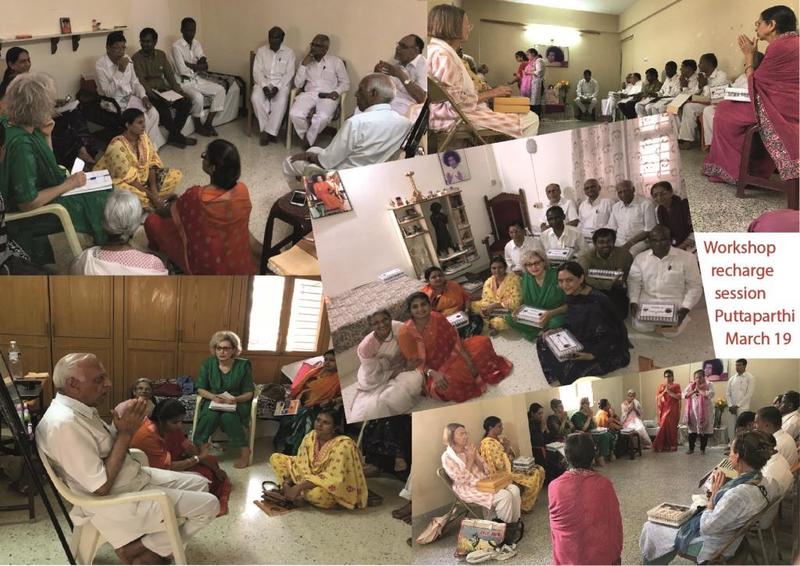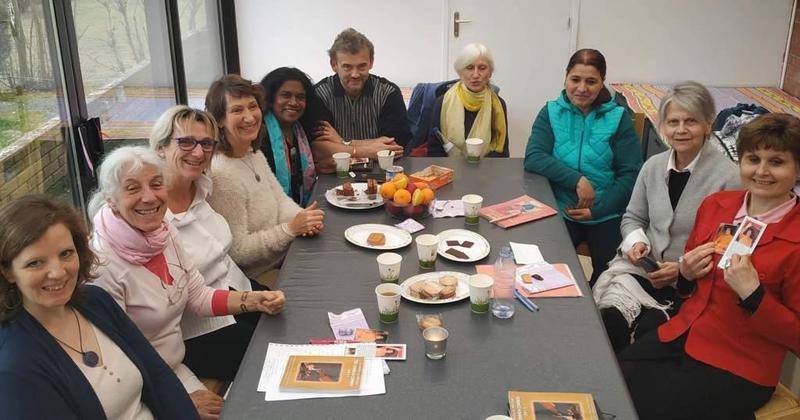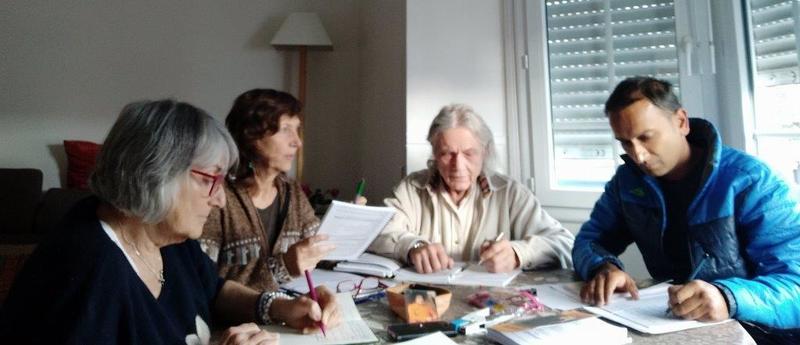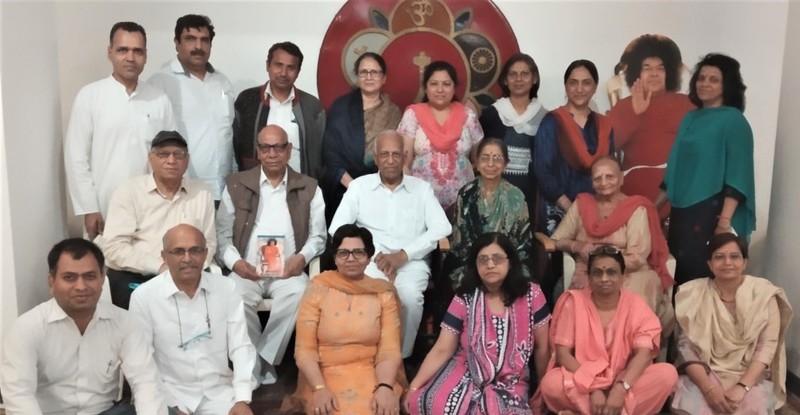In Addition
Vol 10 Issue 3
May/June 2019
1. Taste life with fresh fruits to complement health and happiness
“For the upkeep of the body you need proteins and vitamins of every kind…Take fruits…and vegetables, which can give you any amount of strength”…Sri Sathya Sai Baba1
1. What is a fruit?
One of the precious gifts from mother earth, a fruit is the fleshy edible product of a tree or a plant and contains seed(s). Primary purpose of a fruit is to protect and disseminate the seed to conserve the ecological balance. By grace, it is available to appease the hunger and thirst of human beings and to enable them to live in tune with nature.2-4
Fruits are normally sweet or sour and can be eaten raw. As understood in common parlance, they include: banana, mango, sapota, papaya, apple, pear, guava, pomegranate, melon, grapes, pineapple, orange, grapefruit, peach, plum, cherry, kiwi, fig, apricot and berries. Science says well known vegetables like, cucumber, tomato, bell pepper, pumpkin, and eggplant are also fruits; legumes, some spices, and even whole grains are actually seeds with a thin fruit wall. Nuts are also fruits with hard shells. In 1893, the Supreme Court of US ended the debate between fruits and vegetables by declaring tomato as a vegetable because people thought so and had it as a vegetable and not as a fruit or a dessert.5-7
2. Benefits of fruits
Ideally, our food should have a water content higher than our body’s water content. Fruits are 90% water and keep the body hydrated and energised. A study based on ancient Indian treatises suggests that it is best to eat water through fruits and if 30% of our diet is fresh locally grown seasonal fruits, one would not fall sick.8-9
Every fruit is a complete food in itself, very nutritious, and being easily digestible does not stress our body system. It is low in calories and high in minerals, vitamins, and fibre; can also meet 10% of our daily protein requirement.5,8,9,10
All fruits are beneficial as they tone the vital organs and prevent diseases like diabetes, heart ailments, digestive disorders, prostate enlargement, kidney stones, and cancer; they balance hormones, reduce bone loss with age, regulate blood pressure, and build immunity. Each fruit has something unique to offer. Therefore, it is best to go for a variety of fresh fruits available in the local market, not frozen, canned, or processed ones. Seasonal fruits help to ward off the disorders that tend to come with each season. When we eat from the land around us we will find that the right kind of fruit is coming our way in the right season ie, the best thing to eat at that time eg, melons and mangoes during hot weather. One would get full benefits if fruits are taken in their natural form without discarding the seeds and skin, as far as possible, instead of fruit juice.5,9,11
Diabetic patients will benefit by taking seasonal whole fruits, not fruit juices as they might spike the sugar level. Fruits with a low glycaemic index (GI) are a safe choice. Jamun fruit, or the black plum, and strawberries have anti-diabetes properties. Wisdom lies in following the dietary guidelines for diabetics.12-15
Planet friendly: By eating raw and not cooking, we reduce the carbon footprints and help the environment. Fruits come from trees, not from ploughed land and crop, ecologically it will make a huge difference to the world. Thus, by eating fruits, we serve the planet too!10,16
3. How and when to take fruits
Cleaning fruits: Wash fruits thoroughly and put them in a bowl half-full of water with one tablespoon of salt and two of vinegar. Let them soak for 20 minutes and wash them again, preferably under running tap water, to remove any stuck residue. Alternatively, one may add a drop of CC17.2 Cleansing or NM72 Cleansing to fresh water for soaking the fruits.17
The peels and coverings of fruits naturally protect the antioxidant vitamins inside. Once fruits are cut, ideally they should be consumed immediately or within 30 minutes. If not possible, refrigerate them immediately; otherwise vitamins in them get oxidised and are of no use.18
Best time for fruits: Not going by the precision of clock only, eat fruits on empty stomach so that body can absorb their nutrition readily and detoxify the system easily. Nothing like a fruit to start the day with!19-22
Fruits do not need the acidic medium of the stomach to digest them; they simply pass through the stomach to the intestine. That is why fruits should be eaten separately, simply without any embellishment, savouring one at a time. Logically, eat fruits at least 30 minutes to one hour before a meal; certainly not as a dessert after a meal.19,20
The process of digestion starts when we put the first morsel into the mouth; it does not wait for us to finish the meal. Except for fruits and vegetables, normally, vegetarian food takes about two to two-and-a-half hours to be digested in the stomach, before it goes into the small intestine. So, snacking on fruits between meals should be at least 2 hours after a meal; otherwise, the fruits may ferment in the body, instead of getting absorbed.19-22
According to a study, citrus fruits are best taken during the day between 10 am and 3 pm, not on empty stomach. Sweet fruits like banana and mango are not considered good before going to sleep as they may spike the energy level and keep one awake.19,22
Ideal quantity of fruits: If daily diet includes vegetables and whole grains, 2 servings of fruits per day should suffice; 150 gm each time, ie, 1 medium size fruit like apple, pear, orange, or banana or 1 cup of cut fruits. If on a fruit fast, one may have a serving thrice during the day, instead of the normal diet. The rule of thumb is “nothing in excess” eg, eating 2 small bananas will help but four will make us dull.23,24
Fruit combinations25-27: Broadly speaking we can classify fruits into three categories: sweet, sour (acid) and sweet/sour (semi-acid). It is the varying proportion of fructose, acid, vitamins, proteins, cellulose and starch found in each type of fruit, that gives it a characteristic taste, determining its category.
Banana, peach, guava, grapes, fig, dates and all kinds of melon (having high water content) are some fruits that are sweet in taste. These fruits contain a much greater amount of fructose than sour fruits.
Black currants, raspberry and kiwi fruit are sour in taste. Citrus fruits like lemon, lime and grapefruit are also sour but at times bitter. They contain a large amount of acid.
Not all fruits are either sweet or sour. Some fruits, such as oranges, pomegranate, pineapple, apple, mango, pear, papaya, strawberry and blackberry contain almost equal amounts of fructose and acid, which gives them both a sweet and sour taste.
Fruits of one category get digested at the same pace and hence can be combined. Sweet fruits should not be combined with sour fruits. However sweet/sour fruits may be combined with sweet fruits or with sour fruits.25-27
4. Cautionary tips
Science of ayurveda says that for good health food intake should be compatible with the five elements - ether, air, fire, water and earth - present in everybody. Inappropriate food combinations confuse the digestive fire in the body and cause imbalances. Accordingly:19
- Go for solo fruit diet without mixing it with anything but not when the stomach is full.
- Drink water at least half to one hour before taking a fruit but not soon after, to avoid digestive disturbances like flatulence or diarrhoea.
- Do not combine fresh fruits with raw or cooked vegetables.
- Even sweet fruits should not be combined or taken along with milk as our body, after the age of 2-5 years, does not produce enough enzyme (lactase) needed to digest milk protein.28 When fruits are combined with milk, we would not only lose the goodness of fruits but also pave the way for illness by overloading the system. 29
5. The Final Word!
Sometimes general guidelines may not work for some individuals, as body constitution differs and each human being is unique. Paying attention to what we eat and being aware of how they make us feel is more important. If we heed the signal from the body, we would know what is best for us, when and how much to eat.
References and Links:
- Health, Food, and Spiritual Disciplines, Divine Discourse 8 October 1983, Sathya Sai Baba Speaks on Food, Sri Sathya Sai Sadhana Trust, Publications Division, First edition, 2014, page 56.
- What is a fruit: https://www.organicfacts.net/health-benefits/fruit
- https://www.cropsreview.com/functions-of-fruits.html
- http://www.uky.edu/hort/Ecological-importance-of-fruits
- Types of fruit: https://www.nutritionadvance.com/healthy-foods/types-of-fruit/
- Tomato is vegetable: https://www.livescience.com/33991-difference-fruits-vegetables.html
- https://en.wikipedia.org/wiki/Nix_v._Hedden
- Eat water through fruits: https://www.youtube.com/watch?v=gSYsI3GCbLM
- https://isha.sadhguru.org/us/en/wisdom/article/fruit-diet-good-for-you-planet
- Fruits have protein: https://www.myfooddata.com/articles/fruits-high-in-protein.php
- https://www.healthline.com/nutrition/20-healthiest-fruits
- For diabetics: https://www.everydayhealth.com/type-2-diabetes/diet/fruit-for-diabetes-diet/
- https://diabetes-glucose.com/fruit-diabetes-diet/
- https://www.onlymyhealth.com/health-slideshow/best-fruits-diabetics-eat-1271667125.html
- https://drmohans.com/dos-and-donts-in-diabetes/
- Impact on planet: https://www.independent.co.uk/life-style/health-and-families/veganism-environmental-impact-planet-reduced-plant-based-diet-humans-study-a8378631.html
- Washing fruits: Manual for Senior Vibrionic Practitioners, 2018, chapter 9, A.6, page86; Newsletter, vol.8, # 5, Sept-Oct 2017, Health Tips, Enjoying food the healthy way, para 6, https://news.vibrionics.org/en/articles/228
- Cut fruits: https://www.verywellfit.com/fruits-vegetables-cut-nutrients-lost-2506106
- Healthy Fruit eating: http://www.muditainstitute.com/articles/ayurvedicnutrition/secrettohealthyfruiteating.html
- https://www.quora.com/Do-fruits-need-stomach-acids-to-get-digested
- http://www.ibdclinic.ca/what-is-ibd/digestive-system-and-its-function/how-it-works-animation/
- https://www.ayurvedabansko.com/fruits-and-vegetables-in-ayurveda/
- How much to eat: https://www.eatforhealth.gov.au/food-essentials/how-much-do-we-need-each-day/serve-sizes
- How much Satvic food: http://www.saibaba.ws/teachings/foodforhealthy.htm
- Food combinations: https://lifespa.com/fruit-ayurvedic-food-combining-guidelines/
- https://www.ehow.com/info_10056003_sweet-vs-sour-fruits.html
- http://www.raw-food-health.net/listoffruits.html#axzz5mXlWmuVw
- Inadequate lactase in adult to digest milk: https://healthyeating.sfgate.com/milk-digestible-4441.html
- Science of nutrition-yogic view: https://www.kriyayoga-yogisatyam.org/science-of-nutrition
2. AVP workshop in Puttaparthi, India, 6-10 March 2019
Eight candidates, six from India (including two medical practitioners, now doing voluntary service in General Hospital, Puttaparthi) one from France, and one from Croatia qualified as AVPs after going through an intense 5-day workshop including a mock clinic conducted by two experienced course teachers10375 &11422. The workshop was also attended by 4 qualified practitioners to refresh their knowledge. Inputs from the two doctors enriched the workshop and made it very lively and interactive. The participants gave suggestions to make the course content more practical by allocating more time for mock/field clinics. There was also a dedicated session on how to write case histories, with practical examples, and the advantage of maintaining meticulous patient records for this purpose.
 The participants were treated to illuminating talks by Dr Aggarwal who shared with them how this powerful therapy developed, guided by Swami physically at every step and His guidance still continues and how practising vibrionics can be life changing for practitioners.
The participants were treated to illuminating talks by Dr Aggarwal who shared with them how this powerful therapy developed, guided by Swami physically at every step and His guidance still continues and how practising vibrionics can be life changing for practitioners.
3. Awareness and Refresher seminar, Cambrai, France, 9 March 2019
In her endeavour to update the practitioners’ data, the French coordinator 01620 came across several old time practitioners, with only SRHVP, who showed keenness to retrain in the system, especially in the use of 108CC box. She arranged an awareness programme on vibrionics in a practitioner’s house; this was attended by 9 participants. They were updated on how vibrionics had evolved over the years and was still evolving, and how each one could play a significant role. She showed them the vibrionics literature readily available in books including the first international conference book and on our main site.  There was enthusiasm amongst all of them to learn and actively participate in the our mission and also bring other friends back into the vibrionics fold. Some of the participants already had the 108CC box and took this opportunity to share their experiences and re-charge their boxes.
There was enthusiasm amongst all of them to learn and actively participate in the our mission and also bring other friends back into the vibrionics fold. Some of the participants already had the 108CC box and took this opportunity to share their experiences and re-charge their boxes.
4. SVP workshop and Refresher, Perigueux, France, 16-20 March 2019
A five-day SVP course was conducted by the French coordinator & trainer 01620 at her residence. She set the tone by highlighting the role and responsibilities of becoming an SVP which was appreciated by the participants. The VP who made the effort of coming all the way from Mauritius performed brilliantly and on qualifying as an SVP made a remedy there and then on the SRHVP for his co-participant.  Two SVPs who had qualified a year ago took an active part by sharing their experiences and case histories. They also found the intense 5-day workshop invaluable. The course concluded with an informative question & answer session with Dr Aggarwal on Skype.
Two SVPs who had qualified a year ago took an active part by sharing their experiences and case histories. They also found the intense 5-day workshop invaluable. The course concluded with an informative question & answer session with Dr Aggarwal on Skype.
5. Refresher workshop in New Delhi, India, 23 March 2019
A stimulating workshop organised at the Sai International Centre by Delhi co-ordinator and teacher 02059 was attended by 19 practitioners who also shared their successful and difficult cases. Dr Aggarwal urged the participants to continue practising vibrionics as a ceaseless selfless service with gratitude and surrender to the Lord in the true spirit of the oath taken in front of Swami. Keep striving to go to the next level, update knowledge and upgrade skills continuously, believe in team work, and come forward to take up administrative roles to make vibrionics grow in the right direction.
Core and vital aspects of vibrionics that were recently touched upon in the newsletters were dealt with at length. Some of these were:
- Necessity to make alternative arrangements in advance for the patients if a practitioner is going to be away from home for over 2 weeks
- To exercise caution while preparing a remedy such as eye drops in boiled and cooled water, and ear-drops in pure oil/ghee; efficacy of application of water for skin problems, rather than oil, cream, or gel, and importance of taking pictures as per guidelines regarding the angle, distance, and affected area; and importance of recharging of 108CC box every 2 years.
- Inspire and guide patients about a healthy lifestyle including a proper diet, sleep, exercise, and deep breathing in fresh air.
- While preparing remedy, let patients go through our newsletters/conference book to augment their faith in vibrionics.
- Gradually taper remedies after symptoms subside, and then help build the immunity of the patient through alternating cleansing and immunity booster remedies for prevention, and later treat with miasms to eradicate the disease from the root.
- Forgiveness technique to clear the mind of baggage.

